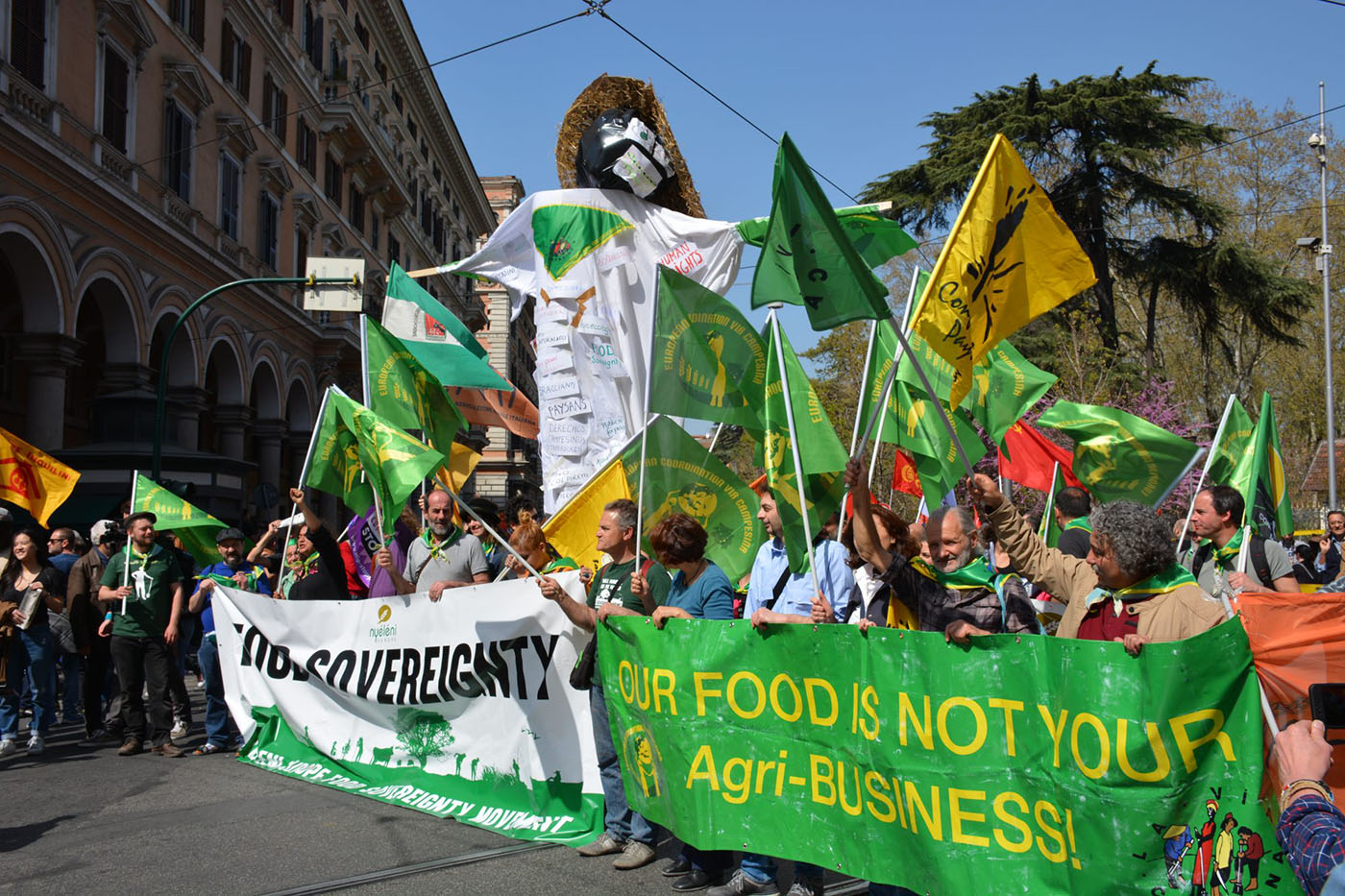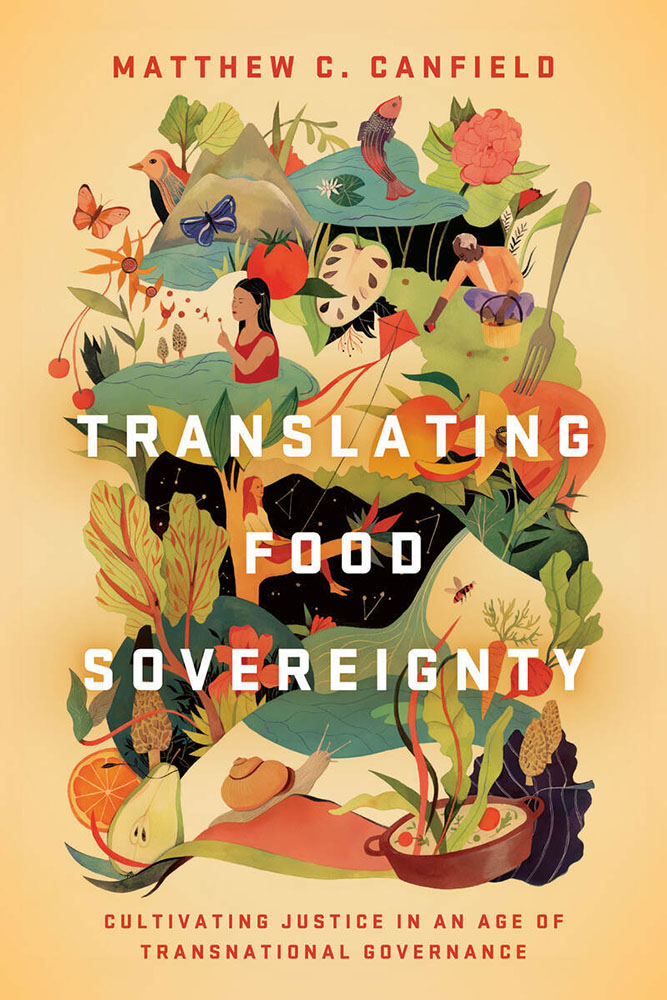
Food sovereignty activists are fighting for more just and sustainable food systems the world over.
Excerpted from Translating Food Sovereignty: Cultivating Justice in an Age of Transnational Governance, by Matthew C. Canfield, published by Stanford University Press, ©2021 by the Board of Trustees of the Leland Stanford Junior University. All Rights Reserved.
Matthew Canfield
In 2011, I crowded into the basement of a small church in downtown Oakland, California, with activists from across the country for the first US Food Sovereignty Assembly. It was just three years after a global food and financial crisis had upended the global economy. In a political moment gripped with concern over economic inequality, food was becoming a powerful symbol and site of social change. As people began to arrive at the church, I was immediately struck by those who had been invited. They did not resemble the hippies, hipsters, and affluent white consumers I had come to associate with “food activism.” They included the people most marginalized and exploited by the industrial food system: migrant seasonal farmworkers, Indigenous communities, organizations of the urban food insecure, and small family farmers. These were not groups that had typically been politically aligned. In fact, they had often been pitted against one another as competing interest groups in US food and agricultural policy. Yet in the previous three years a small group of US-based activists with links to burgeoning global peasant movements had assembled these groups with the hope of uniting them over their shared grievances. Sitting in the back of the room as a volunteer notetaker, I watched with curiosity, wondering what it would mean for these groups to claim “food sovereignty.”

Over the past two decades, millions of people across the world have taken up the claim of food sovereignty. The claim was first articulated in the 1990s by small-scale food producers in the transnational social movement La Vía Campesina, the International Peasants’ Movement. Food producers initially united to oppose the threats to their lands, livelihoods, and diets posed by the liberalization of food and agricultural markets through the World Trade Organization. Almost immediately after it was articulated, however, the claim of food sovereignty quickly spread. By the mid-2000s, when skyrocketing food prices caused a global food crisis, other constituencies of food systems, including food-chain workers, fisherfolk, and poor urban consumers, also began to claim food sovereignty to demand local control over their food systems. Food sovereignty alliances now exist in almost every region of the world, making food sovereignty one of the most widely mobilized contemporary social justice claims.
The precipitous rise of movements claiming food sovereignty reflects the state of contemporary food systems. Today there is widespread agreement that our current global food system is socially and ecologically unsustainable. Despite the consistent global consensus of the need to end global hunger, more than 2 billion people in the world lack access to adequate food, including 37 million people in the United States. Beyond food insecurity, malnutrition is also surging. If one combines both of its forms (over-and underconsumption), malnutrition now constitutes the world’s number one cause of ill health. Although powerful nations and corporations have consistently pushed the expansion of industrial agriculture, it is clear that this system has not only failed to address hunger but is also responsible for vast ecological devastation. The global food system is one of the largest contributor to global greenhouse gas emissions, deforestation, and the destruction of global biodiversity.
These problems were made even more manifest during the coronavirus pandemic. During the worst of the crisis, newspapers in the United States printed stories of farmers dumping milk and euthanizing livestock alongside pictures of snaking lines of cars waiting outside food banks and workers jammed together at meat processing plants suffering from high infection rates. The US food system—once celebrated as the apotheosis of abundance and efficiency—was revealed to be a shaky structure crippled by corporate consolidation. In the United States we are witnessing growing monopolistic control over the food and farming sector. Four or fewer firms control the market for agro-inputs, beef and grain processing, and many major food commodity chains. Globally, four or fewer firms also control almost all commercial agricultural inputs. Just four companies control 60% of the global commercial seed industry and 90% of the global grain trade, and three companies control 70% of the agrochemical industry. This centralization of control over food systems in the hands of so few is a driving factor in many of the problems that we are seeing today. As the International Panel of Experts on Sustainable Food Systems puts it, the industrial food system is just “too big to feed.”
The activists gathered in Oakland were all organizing in response to these issues. Many of them shared these same grievances. But over the course of the day-long meeting it became clear that they also had different priorities. Farmworkers on the West Coast were fighting for fair working conditions in the industrial food system, whereas Indigenous communities were seeking to rebuild their traditional food systems after centuries of settler colonialism and unhealthy donations from the commodity food system. Other groups, such as the Detroit Black Community Food Security Network, were working to dismantle racism in the food system and create consumer cooperatives and urban farms to promote urban food security. Even though the participants of the assembly came up with a long list of rights—from the rights of Mother Earth to the right to access land—none of these claims captured their disparate struggles. In a country in which the language of rights has served as the dominant grammar for social justice movements, the activists participating in the US Food Sovereignty Assembly wrestled to consolidate their demands into a single claim that simultaneously respected their diversity and united them into a movement.
As the debate unfolded, it was clear that they faced profound strategic questions: What would it mean to claim sovereignty rather than rights? How could they translate food sovereignty across their divergent contexts? And how could a claim that was developed in the global South be adopted and mobilized by activists in the very different political, economic, and agrarian context of the United States?
LAW AND SOCIAL MOVEMENTS IN AN AGE OF NEOLIBERAL GLOBALIZATION
Participants’ struggle to reconcile their repertoires of rights claiming with the language of food sovereignty is a product of the way that social movements have constituted social justice claims for the past few generations. In the 1950s and 1960s, rights mobilization became the dominant approach through which individuals and groups articulated claims on society and the state in liberal democracies. The civil rights movement, the women’s movement, the LGBTQ movement, and the disability rights movement, among others, all drew on rights-based strategies to seek inclusion into society and demand economic redistribution. By claiming rights, movements consolidated not only their demands but also their collective identities. This “rights revolution” spread globally with the proliferation of human rights as a shared global language of social justice beginning in the 1970s.
Today, however, both scholars and social movements are increasingly recognizing the limits of social and economic rights claims in the face of neoliberal inequalities. Rights-based approaches to social change are constrained by the shifting geographies of power produced by neoliberal globalization. Rights are premised on a vision of the world in which nation-states operate the primary regulatory authority. Since the 1970s, however, the state-centered hierarchical framework of public international law and national economic regulation has been rolled back through deregulation, privatization, and the liberalization of global markets. As Saskia Sassen describes, neoliberalism reorganized the relationship between territory, authority, and rights on a global scale by partly denationalizing some state capacities. Today, as international law grows increasingly fragmented, rights operate as just one normative form through which power operates, amid proliferating forms of governance.
As a result, critical voices are increasingly questioning the emancipatory possibilities inherent in rights discourse. A recent wave of scholarship has revealed how human rights ascended as the primary framework for imagining social justice just as the architects of neoliberalism were institutionalizing the market economy as the principal and governing logic at the national and international level. Analyses tracing the concurrent rise of human rights discourse and neoliberalism build on a long corpus of critical theory that has been skeptical of rights. Feminist and Marxist analyses have consistently argued that rights offer a narrow frame for social justice claims because they remain rooted in “liberal legalism,” an ideology of law premised on individual rather than collective rights, private property, and formal equality. Liberal legalism’s endeavor to separate the “public” sphere of political equality and the “private” sphere of liberty—the domain of the economy and family—has consistently served as a stumbling block for generations of social movements seeking egalitarian social change.
Postcolonial critics also challenge the transnational culture of modernity that human rights language often reproduces. Rights discourses emerged from the European Enlightenment and colonial project and today still carry the values of Eurocentric modernity. They remain premised on a universal, secular vision of human nature and atomistic worldview that separates humans from nonhuman nature and privileges the individual as the primary legal subject. Human rights have consistently been mobilized by powerful states in the global North to distinguish between “traditional” and “modern,” “savage” and “savior,” thereby reproducing a Northern-centered world order that maintains colonial hierarchies of power. Although rights remain an important legal and symbolic resource, both social movements and sociolegal scholars are learning that rights are “not enough,” as Samuel Moyn puts it, to challenge the overlapping inequalities produced through centuries of colonialism, capitalism, and neoliberalism.
The organizers of the first US Food Sovereignty Assembly seemed to intuitively understand these constraints. Just as the assembly drew to a close and the participants became embroiled in a debate over their priorities, a handful of the assembly’s organizers who had more contact with food sovereignty movements outside the United States intervened. One activist who had extensive experience organizing with La Vía Campesina in Latin America explained that food sovereignty did not take what she called a top-down “command and control” approach to political change but rather sought to decentralize control over food and agriculture. Another grassroots activist explained that food sovereignty was best understood through the “three P’s”—people, places, and platforms. She said that food sovereignty was mobilized by marginalized peoples, was rooted in specific places and contexts, and offered a shared platform for struggle. At the time, I did not quite comprehend these activists’ interventions. Yet over the next seven years, I began to understand that these activists were radically recalibrating their horizons of social justice and developing new practices of mobilization in response to the metamorphosis of capitalism and regulation in an era of neoliberal globalization.
CULTIVATING TRANSNATIONAL GOVERNANCE FROM BELOW
…Critical observers have described how the rise of transnational governance is reordering power and authority through the economic logics of the market and producing a new era of corporate rule, but few have attended to the ways that activists are responding to the changing cultural and symbolic politics of this regulatory order by producing new social justice claims and conditions of possibility. Indeed, as transnational governance blurs the boundaries once established by liberal legalism to establish constraints on power, it offers both new opportunities and constraints. On the one hand, transnational governance draws on symbols that appeal to social movements. The networked form of transnational governance implies horizontal relations and social ties. It relies on collaboration, participation, and inclusion of actors beyond the state. By constituting claims in relation to transnational governance, food sovereignty activists demand the inclusion of those most marginalized in public policymaking. Moreover, they are able to articulate food sovereignty as a holistic social justice claim that transcends the divisions between public and private imposed by liberal legalism and Euro-modernism. On the other hand, however, transnational governance is often initiated from the top down, by elites who seek to extend market logics and manage their “externalities,” not radically upend them. For neoliberals the networked form of transnational governance provides a framework for the dissemination of neoliberal reason and market values. As a result, transnational governance also enables the deeper domination by powerful market actors by dismantling previous institutional and symbolic forms of regulation that have endeavored to set limits on power.
Food sovereignty activists are well aware of this paradox. They encounter it continuously as they engage in multistakeholder and collaborative arenas of governance that produce the voluntary guidelines, private certifications, and codes of conduct through which transnational governance operates—all of which they are deeply skeptical of. Yet by dialectically constituting claims for food sovereignty in relation to these emerging forms of governance, I argue that they are cultivating decentralized, democratic networks through which they are reconfiguring relations between communities, nature, and markets. In doing so, they are producing what I call governance from below.



